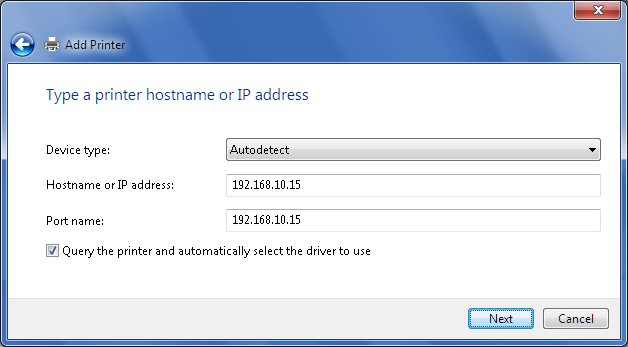3. Installing Network-Attached Printers, Scanners, and Fax
Machines
A network-attached printer, scanner, or fax machine is a
device that’s attached directly to the network using a wireless
connection or a network cable. Network-attached printers, scanners, and
fax machines are configured so that they’re accessible to network users
as shared devices.
If you configure the printer and enable sharing, the
computer on which you configure the print device becomes an additional
print server for it. When you install this printer on
another computer, you might see two listings: one for the device
itself, and another for the shared printer on the computer that is
sharing it. Unless you want your computer to act as a print server,
you might want to select “Do not share this printer” in step 5. |
|
You can install a network-attached printer or fax machine by
completing these steps:
Click Start→Devices and Printers. In Devices and Printers,
click “Add printer.” This starts the Add Printer Wizard.
In the Add Printer Wizard, click “Add a network,
wireless or Bluetooth printer.” The Add Printer Wizard will then
begin searching for available devices.
If the wizard finds the device you want to use, click it in
the list of devices found. Click Next.
NOTE
If your computer can’t find the network printer, make
sure that the printer is powered on and that a firewall isn’t blocking connectivity to the printer. You
may need to open a firewall port to allow access between the computer
and the printer. If your network consists of multiple subnets
connected together, try to connect the printer to the same network
subnet. Also, make sure the printer is configured to broadcast its
presence on the network. Although most network printers automatically
do this, this isn’t always the case. Finally, make sure that the
printer has an IP address and proper network settings. With DHCP,
network routers assign IP addresses automatically as printers connect
to the network. After you’ve double-checked everything, click Search
Again to have your computer search again for the printer. If this
resolves the problem, select the printer and then click Next to
continue this procedure. Otherwise, skip the remaining steps and
follow the next procedure to install the printer manually.
On the “Type a printer name” page, type a name for the device
or accept the default name. You’ll see this name on the Printers
page in the Control Panel. Click Next.
The printer is automatically configured for sharing. If you
don’t want the printer to be shared, select “Do not share this
printer.” Otherwise, you can set the share name and location and add
an optional comment.
When you click Next, the Add Printer Wizard will install the
printer and set it as the default automatically. If you don’t want
the printer to be the default, clear the “Set as the default printer” checkbox (you will see
this checkbox only if you had a default printer before you installed
this one).
To print a test page, click “Print a test page.” The wizard
will then print a test page. Click Close.
Click Finish. Click Start→Devices and Printers. The Devices
and Printers page in the Control Panel will have an additional icon
with the name set the way you specified. You can change the printer
properties and check printer status at any time.
If the Add Printer Wizard doesn’t find the network printer you
want to use, complete the installation by following these steps:

On the “Searching for available printers” page, click “The
printer that I want isn’t listed” and then click Next.
On the “Find a printer by name or TCP/IP address” page, select
“Add a printer using a TCP/IP address or hostname,” and then click Next.
On the “Type a printer hostname or IP address” page, shown in
Figure 12, use the “Device
type” list to select the type of device. If you don’t know the type
of device, choose Autodetect.
In the “Hostname or IP address” text box, type the hostname or
Internet Protocol (IP) address of the device. If you are unsure, use
the device’s control menu to print a configuration page.
The port name is set for you based on the hostname or IP
address entry. The port name doesn’t matter as long as it’s unique
for your computer.
When you click Next, the wizard attempts to contact the device
and automatically determine the protocol details as well as the
adapter type. If the wizard is unable to detect the print device,
make sure that the print device is turned on and connected to the
network. Also, ensure that you typed the correct IP address or
printer name in the previous page. If you entered incorrect
information, click the Back arrow and then retype this
information.
Complete the installation by setting the printer name and
sharing options as discussed in the previous procedure.
Xerox makes a network-attached scanner called the Xerox
WorkCentre Pro Scanner. This device and other similar devices install in
the same way as a directly attached scanner. When you complete the
installation, the scanner should be configured automatically. If it
isn’t, follow these steps to set the IP address for the scanner:
In Windows Explorer, access C:\Program Files\Windows Photo Viewer,
where C: is your system drive, and then double-click ImagingDevices.exe.
In the Scanners and Cameras window, click the scanner and then
click Properties.
On the Device Settings tab, type the hostname or IP address of
the scanner and then click OK.